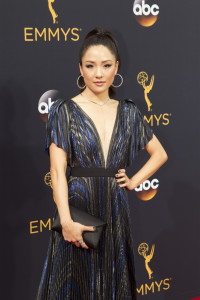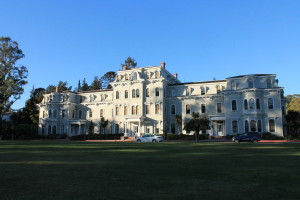
Artist Klea McKenna often works outside in the dark, only during new moons, with instinct guiding her. She captures leaves, dewy spider webs and even rain in her photograms.
McKenna spoke in the Art Lecture Series in Danforth Lecture hall on March 1. Her presentation was broken into four acts that she categorized as stages in her art and life.
“My art makes itself, and then I figure it out,” McKenna said.
Gail Cooper, MFA student, introduced McKenna. She felt McKenna’s work showed the viewers other ways of seeing the world, not through describable moments, but through arousing emotions.
“I felt the way she was navigating the work, going about making the work, shows [her] trying to get at a place of feelings that don’t evoke words,” Cooper said. “Artists have a way of dissecting the world and repurposing it. She’s doing exactly that.”
McKenna got her bachelor’s degree from UC Santa Cruz in 2002 and her MFA from the California College of the Arts in 2009. McKenna broke away from her formal photographic training around 2008, and she started searching for a different way to access photography without going through the formal process, giving up some of the control along the way.
“The magic had gone out of our relationship,” McKenna said of her relationship with the formal photographic process. “I was trying intentionally to undo my process.”
She worked with building her own cameras and filling them with water or live bugs, damaging film and photograms, which are images on light-sensitive paper without a camera, for a while. Eventually, she settled on the photogram as her medium, and around 2011 she started heading back towards more control in the process.
“I had lost control enough that the magic was coming back to me,” McKenna said.
Now when she goes out, she operates by her instinct. She says the delay between her going out and developing the images means that the risk for failure is high since she does not get immediate feedback about what she needs to change.
“Every process I do has a period of not producing anything before it does,” McKenna said.
One of her first slides showed a volcano on Kilua, HA. She grew up in Hawaii, with ethnobotanist parents, surrounded by plant communities, and said she is influenced by the rupture of the land.
“I’ve always been interested in [the rupture], but I haven’t been able to articulate it always,” McKenna said.
Her relationship with nature seems to follow the same vivid lines. She sees allegories in nature for human relationships.
“When I’m in a landscape, it feels like being in a crowd,” McKenna said. “It feels psychologically and emotionally complex…if you think about drama in human experience. That’s where the mundane ruptured.”

This fascination in the schism appears in her collection “Automatic Earth” which was made up of ‘photographic rubbings’ where the dips and peaks created by the rubbings catches the light when the paper is exposed. It featured photograms of tree trunks, and one crack that she layered to appear as though it was many cracks instead. That crack in the ground was extended to snake down the wall of the gallery in another piece.
Before she had a child, McKenna would return to Hawaii during the new moon and work on her photograms. It would be weeks before she could see the results. If she made a mistake, it would show up after she had returned from her trip. Even working near her studio, she would get feedback the next day, and then have to go back out and try again, or wait for the next new moon.
“She’s a scientist in a not scientific way,” Cooper said. “She’s testing her own theories.”
Each trial would slowly help McKenna finesse her operation and answer technical questions like what angle to expose the photograms at and whether they need multiple exposures. The batches that don’t come out the way she wants do not deter her.
“That’s part of the thrill,” McKenna said. “I absolutely believe that as an artist, the process has to fuel you no matter the product.”
After having a child, McKenna experienced ten months of postpartum depression.
“Becoming a mom, I came face to face with my fragility,” McKenna said. “I still had tons of ideas, and yet every time I would reach for one it would wither on the vine.”
Now, she is able to look back at that experience with postpartum depression and feel more connected to what she wants to create.
“I am much more aware of how confidence and self-doubt play in my art,” McKenna said. “I feel tapped into what I mean… I feel like my charger is plugged into electricity.”
MFA student Gregory G. Geiger attended the talk. A self-proclaimed ‘photo nerd,’ Geiger knew of McKenna before the lecture.
“Her rain piece, wood rubbings, that’s a new way of thinking about photography and I think that comes from her love of photography and history,” Geiger said. “That’s rain being captured; that’s wood, being captured.”



